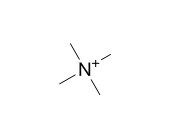Tetramethylammonium
Tetramethylammonium ion has limited toxicity of dermal exposure, but fatal effects can be introduced by pre-treatment with hydroxide ion.
Inquire / Order:
manager@chemfaces.com
Technical Inquiries:
service@chemfaces.com
Tel:
+86-27-84237783
Fax:
+86-27-84254680
Address:
1 Building, No. 83, CheCheng Rd., Wuhan Economic and Technological Development Zone, Wuhan, Hubei 430056, PRC
Providing storage is as stated on the product vial and the vial is kept tightly sealed, the product can be stored for up to
24 months(2-8C).
Wherever possible, you should prepare and use solutions on the same day. However, if you need to make up stock solutions in advance, we recommend that you store the solution as aliquots in tightly sealed vials at -20C. Generally, these will be useable for up to two weeks. Before use, and prior to opening the vial we recommend that you allow your product to equilibrate to room temperature for at least 1 hour.
Need more advice on solubility, usage and handling? Please email to: service@chemfaces.com
The packaging of the product may have turned upside down during transportation, resulting in the natural compounds adhering to the neck or cap of the vial. take the vial out of its packaging and gently shake to let the compounds fall to the bottom of the vial. for liquid products, centrifuge at 200-500 RPM to gather the liquid at the bottom of the vial. try to avoid loss or contamination during handling.
Sci Rep.2019, 9(1):4646
Front Plant Sci.2022, 12:811166.
Journal of Pharmaceutical Investigation2024, 024-00662-1.
J Biosci.2020, 45:46.
Foods.2021, 10(6):1378.
J Mol Recognit.2020, 33(2):e2819
Phytochemistry.2021, 181:112539.
Cell Metab.2020, S1550-4131(20)30002-4
Processes2024, 12(8), 1563
Nutrients.2023, 15(24):5020.
Related and Featured Products
Arch Microbiol. 2015 Mar;197(2):197-209.
Isolation and characterization of a tetramethylammonium-degrading Methanococcoides strain and a novel glycine betaine-utilizing Methanolobus strain.[Pubmed:
25319587 ]
Two novel strains of methanogens were isolated from an estuarine sediment with the capability to utilize quaternary amines.
METHODS AND RESULTS:
Based on the 16S rRNA analysis, strain B1d shared 99 % sequence identity with Methanolobus vulcani PL-12/M(T) and strain Q3c shared 99 % identity with Methanococcoides sp. PM1 and PM2, but our current isolates display clearly different capabilities of growth on quaternary amines and were isolated based on these capabilities. Strain Q3c was capable of growth on Tetramethylammonium and choline, while strain B1d was capable of growth on glycine betaine. Ml. vulcani PL-12/M(T) was incapable of growth on glycine betaine, indicating an obvious distinction between strains B1d and PL-12/M(T). Strain Q3c now represents the only known Tetramethylammonium-utilizing methanogen in isolation. Strain B1d is the first quaternary amine-utilizing methanogen from the genus Methanolobus.
CONCLUSIONS:
This study suggests that quaternary amines may serve as ready precursors of biological methane production in marine environments.
Chemosphere. 2015 Feb;120:299-304.
Toxicity of tetramethylammonium hydroxide to aquatic organisms and its synergistic action with potassium iodide.[Pubmed:
25151133]
The aquatic ecotoxicity of chemicals involved in the manufacturing process of thin film transistor liquid crystal displays was assessed with a battery of four selected acute toxicity bioassays.
METHODS AND RESULTS:
We focused on Tetramethylammonium hydroxide (TMAH, CAS No. 75-59-2), a widely utilized etchant. The toxicity of TMAH was low when tested in the 72 h-algal growth inhibition test (Pseudokirchneriellia subcapitata, EC50=360 mg L(-1)) and the Microtox® test (Vibrio fischeri, IC50=6.4 g L(-1)). In contrast, the 24h-microcrustacean immobilization and the 96 h-fish mortality tests showed relatively higher toxicity (Daphnia magna, EC50=32 mg L(-1) and Oryzias latipes, LC50=154 mg L(-1)). Isobologram and mixture toxicity index analyses revealed apparent synergism of the mixture of TMAH and potassium iodide when examined with the D. magna immobilization test. The synergistic action was unique to iodide over other halide salts i.e. fluoride, chloride and bromide.
CONCLUSIONS:
Quaternary ammonium ions with longer alkyl chains such as tetraethylammonium and tetrabutylammonium were more toxic than TMAH in the D. magna immobilization test.
Burns. 2012 Nov;38(7):1051-7.
The role of the chemical burns caused by hydroxide ion in the toxicity of dermal exposure to tetramethylammonium ion in a rat model.[Pubmed:
22698842]
To evaluate the role of the chemical burns caused by hydroxide ion in the fatal effects of Tetramethylammonium ion (TMA) in dermal exposure to Tetramethylammonium hydroxide (TMAH), we conducted a rat study consisting of two-step treatments with dermal exposure to NaOH and Tetramethylammonium chloride (TMACl).
METHODS AND RESULTS:
In the first step, NaOH or saline was administered in the gauze on the shaved skin for 5 min, and in the second step, Tetramethylammonium hydroxide, Tetramethylammonium chloride, or saline was administered in the same way. The mean blood pressure (MBP), heart rate (HR), and survival in rats were compared among seven groups. Dermal exposure to saline and then 2.75 M Tetramethylammonium chloride introduced limited and temporary non-fatal effects. Exposure to 2.75 M NaOH and then saline had almost no effects and caused no deaths. Treatments with more concentrated NaOH or Tetramethylammonium chloride resulted in suppressions of MBP and HR, and deaths were observed after the dosing of Tetramethylammonium chloride.
CONCLUSIONS:
The toxicity of dermal exposure to Tetramethylammonium ion alone is limited, but fatal effects can be introduced by pre-treatment with hydroxide ion. Therefore, the chemical burn caused by hydroxide ion plays an essential role in the toxicity, implicating that effective neutralizing may help decreasing the fatality rate.



